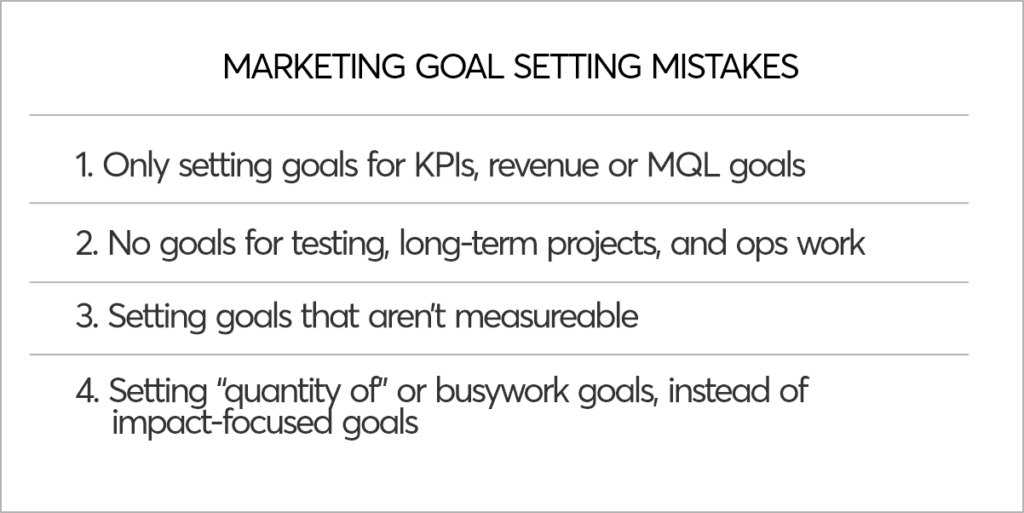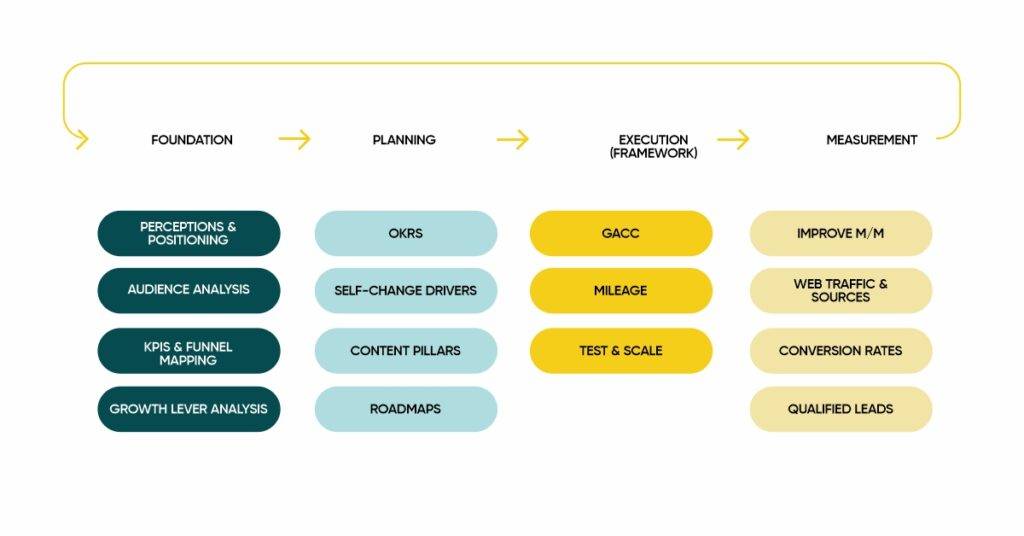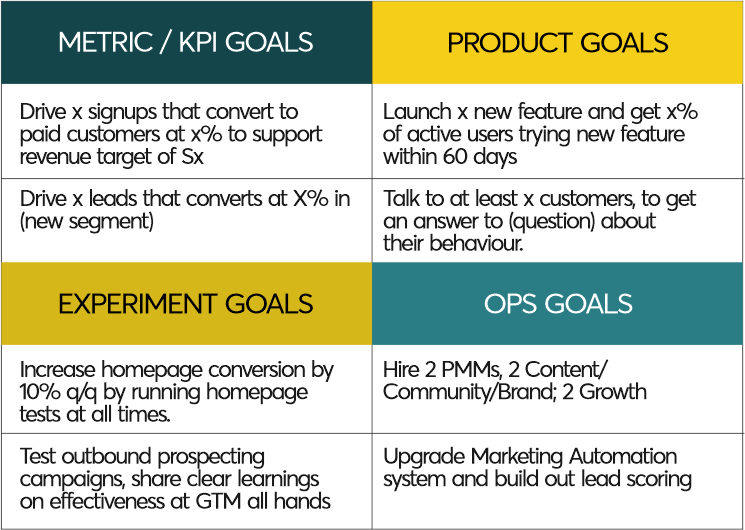
Defining clear goals, sharing them widely, and reviewing them weekly are essential strategies Kathleen and I use to build effective marketing teams and drive growth in startups.
It’s surprising how often marketing leaders lack well-defined goals, rely solely on lead or revenue targets, or set goals that miss the mark on impact—such as “create 10 landing pages.” Here are some common pitfalls we’ve observed:

Marketing Strategy Framework
This diagram outlines our approach to marketing strategy, planning, and execution. While we won’t delve into every aspect of this newsletter, it provides a clear view of how we structure our process.

Establishing a Strong Foundation for Effective Marketing Goals
To set meaningful goals and prioritize your marketing efforts effectively, it’s crucial to lay the groundwork for your marketing strategy (as outlined in the first column on the right). If this foundation isn’t in place yet, consider setting initial goals to address these elements. Here’s how to build that foundation:
Define Your Perceptions
- What Are Perceptions?
- Marketing perceptions are the core ideas you want your audience to associate with your company. They should be distinct and memorable—statements your audience can repeat back to you.
- Why Are They Important?
- Perceptions shape your company’s narrative and influence goals, messaging, and your content roadmap. They ensure consistency and uniqueness in your brand’s story.
- What Else Should You Do?
- As part of this process, conduct a competitive analysis and refine your positioning to highlight what sets you apart.
- Want More Insight?
- Check out our detailed blog on crafting effective perceptions.
Understand Your Audiences and Verticals
- Conduct Audience Analysis
- Dive into audience segmentation and Ideal Customer Profiles (ICPs) to understand who you’re targeting.
- Differentiate Proven vs. Test Audiences
- For multiple audiences, clearly distinguish between proven and test audiences or verticals. This helps set appropriate goals for each segment.
Map Your Funnel Stages and KPIs
- Go Beyond the Basics
- Your funnel should include more than just MQLs, Opportunities, and Closed Won deals.
- Include Top-of-Funnel Metrics
- Track web traffic by source and other metrics that indicate early-stage engagement.
- Focus on Conversion Rates
- Measure the conversion rate between each stage of your funnel to identify opportunities for improvement.
Analyze Growth Levers and Channels
- Understand Your Channels
- Before setting goals, identify which channels are working, which need testing, and which are not effective.
- Categorize Channels and Tactics
- Use labels like “not tested,” “tested but ineffective,” “priority for scaling,” and “not relevant” to streamline your approach.
- Identify Step-Change Drivers
- Pinpoint channels and tactics that could drive significant growth for your business.
By solidifying these foundational elements, you’ll not only create a more effective marketing strategy but also set the stage for achieving impactful, measurable goals.
The Importance of Quarterly Goal Setting in Marketing
While lengthy annual planning sessions may not be necessary for early-stage businesses, dedicating time each quarter to set clear goals can significantly boost focus and ensure impactful work. Here’s why quarterly goal setting is essential:
- Prioritization
- Goals act as a high-level prioritization tool, helping you focus on what truly matters.
- With limited time and resources, having clear goals provides a framework for deciding what tasks to tackle and which to postpone or decline.
- Team Alignment and Scoping
- Clearly defined goals ensure everyone knows their responsibilities and understands collaboration requirements.
- By setting goals, you can identify whether team members are under or overcommitted, allowing for better workload distribution.
- Cross-Company Communication and Coordination
- Goals promote alignment with other departments like sales and product teams.
- Engaging in interdepartmental discussions during the goal-setting process makes it easier to manage one-off requests, as you can justify priorities based on pre-established objectives.
- Strategic Hiring Planning
- Goal setting highlights areas where there’s no clear ownership of tasks or where team members are stretched thin.
- It simplifies hiring decisions by clarifying which roles are essential for achieving the planned work.
- Driving Meaningful Growth
- Goals ensure a clear understanding of the “why” behind your growth initiatives.
- They encourage efforts to achieve step-change growth—dramatic and sustainable improvements—rather than settling for linear or inconsistent progress.
Why It’s Worth It
Investing time in quarterly goal setting ensures that your efforts align with strategic priorities, streamline team operations, and set the foundation for impactful and measurable growth. It’s not just about setting targets; it’s about creating a roadmap for success.

Setting the Right Goals: A Balanced Approach
Once you’ve established a strong foundation and committed to setting impactful goals, it’s crucial to focus on the right types of goals while avoiding common pitfalls. Here’s how you can ensure a balanced approach by incorporating four key goal types:
Metrics/KPI Goals
These goals focus on achieving specific, measurable outcomes within a defined timeframe.
- What they do: Metrics/KPI goals ensure your team is working towards tangible results, such as traffic, conversions, or revenue targets.
- Avoid common mistakes: Ensure the goals focus on outcomes rather than activities. For instance, instead of “Write 10 blog posts,” focus on driving traffic or conversions from those posts.
- Example: Increase web traffic month-over-month with a form conversion rate of at least X%.
Project Goals
These goals emphasize completing specific initiatives, sometimes tied to metrics but often focused on long-term benefits.
- What they do: Project goals help tackle big-picture tasks that may not yield immediate results but are critical for progress, like launches or new content series.
- Why they matter: They ensure that important but non-urgent projects don’t fall by the wayside.
- Example: Launch a new feature to existing users across multiple channels, aiming for X% of active users to try it.
Experiment Goals
Encourage innovation by setting goals specifically for testing and learning.
- What they do: Experiment goals push your team to explore new tactics, improve, and expand their toolkit.
- Why they matter: Without experiment goals, new ideas often get deprioritized. These goals acknowledge the learning curve and focus on iterative improvements.
- Example: Run A/B tests to increase web conversions by 10% quarter-over-quarter.
Ops Goals
Operational goals focus on building infrastructure, processes, tools, or systems that enable your team to scale effectively.
- What they do: These goals drive long-term efficiency and allow your team to work smarter, not harder.
- Why they matter: Establishing the right systems and workflows today will save significant time and effort in the future.
- Example: Upgrade the marketing automation system and implement lead scoring to streamline outreach efforts.
Why Balance Matters
Balancing these four types of goals ensures you’re not just chasing short-term metrics but also investing in long-term growth and innovation. A mix of proven tactics (for linear growth) and experimental projects (for step-change growth) creates a well-rounded strategy that drives sustainable success.
Set your goals with care, and revisit them regularly to adapt to changing priorities and opportunities.

How to set metrics goals
Setting metrics goals is an essential step in building a strong marketing strategy. Here’s how to approach it in a structured and adaptable way:
Start Simple and Evolve
- Begin tracking basic metrics, even if they aren’t perfect for the long term. Over time, refine your tracking as your systems and goals mature.
- Start with blog traffic, then evolve to include engagement and conversion metrics per post.
- Initially track form completions, then transition to tracking Marketing Qualified Leads (MQLs) as a secondary metric once lead scoring is implemented.
Include Secondary Goals for Efficiency and Scalability
- Pair every metrics goal with a secondary goal to ensure quality and efficiency. Without this, you may hit numerical targets but fail to improve the effectiveness of your efforts.
- Instead of just aiming to grow leads from 1,000 to 1,500, ensure the conversion rate to MQLs or opportunities remains steady or improves.
- Use numerical goals combined with efficiency metrics for better outcomes:
- Example 1: “Increase top-of-funnel leads to X while maintaining a conversion rate from lead to MQL of Y%.”
- Example 2: “Boost web traffic but cap paid ad spend at $X or maintain form completion rates above Y%.”
Anticipate Changes in MQL Goals
- Be prepared to adjust lead scoring criteria and the definition of qualified leads based on feedback from sales and learning from campaigns.
- Consider focusing on high-level outcomes such as opportunities generated or form completions, and clearly communicate if scoring adjustments require goal modifications.
Two Methods to Set High-Level Metrics Goals
- Top-Down Approach
- Work backward from revenue targets in collaboration with finance and sales to calculate required leads, web traffic, and other metrics.
- This approach aligns goals with the company’s financial plans and broader objectives.
- Bottom-Up Approach
- Use historical data and conversion rates to forecast realistic goals.
- Start with metrics like web traffic or leads and build upward through the funnel to identify achievable targets based on past performance.
Refine Goals by Asking “Why?”
- Question the purpose behind each goal to ensure it drives meaningful results.
- Example: Instead of setting a goal like “Write 10 blog posts,” ask why this is important. If the answer is “to drive awareness and leads,” the goal should shift to measurable outcomes like “Increase web traffic by X% and form completions by Y%.”
By focusing on well-thought-out metrics goals, you’ll ensure your efforts not only meet numerical targets but also contribute to sustainable growth and efficiency.
Goal setting process
How to Set and Track Marketing Goals
If your company already has a structured process for goal setting, feel free to skip this section.
However, if your organization only sets high-level revenue goals or lacks a formal process for defining marketing-specific objectives, it’s still crucial to establish your own framework for setting and managing marketing goals. Who knows? You might even inspire the rest of your company to adopt it.
Step 1: Define a Clear Cadence
- Establish a regular schedule for setting goals, communicating them to other teams, and reviewing progress with your marketing team.
- Frequency: Set goals quarterly, but if quarterly feels too frequent for your team size, biannual (6-month) goals can also work.
- Collaboration: Ensure other teams, such as sales or product, are involved in the goal-setting process to foster alignment.
Step 2: Break Down Quarterly Goals
- Divide quarterly goals into manageable monthly milestones to ensure steady progress.
- Use a simple status-check system like red, yellow, green to track progress, with comments for context and updates.
Step 3: Create Detailed Summaries for Each Goal
For every quarterly goal, include:
- A clear owner responsible for driving the goal forward.
- Key collaborators who will assist in execution.
- Monthly milestones that act as checkpoints for tracking progress.
- Connection to higher-level objectives, such as annual goals or overarching company initiatives. Tools like Asana can make it easy to nest goals and track alignment.
- Status indicators like red, yellow, green, with accompanying notes to provide clarity.
By establishing a consistent process for setting and monitoring marketing goals, you’ll not only stay on track but also improve alignment across teams and ensure that every effort contributes to your broader objectives. Even a small team can benefit from this structured approach, making progress measurable and ensuring accountability.
If you’re leading a marketing team, this is the single most crucial exercise to ensure your team focuses on meaningful work that drives growth and strengthens your brand for the long term. If you’re a founder, set clear expectations for your marketing leader to establish goals and evaluate their ability to do so during the interview process.
If you’d like to draw inspiration from my marketing goal tracker and annual planning and goal-setting document, I invite you to subscribe here. Upon subscribing, you’ll receive access to our sample annual planning and goal-setting document, along with the marketing goals tracker.
